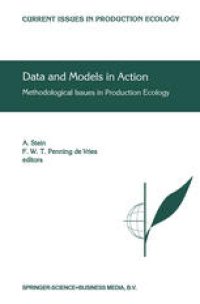
Ebook: Data and Models in Action: Methodological Issues in Production Ecology
- Tags: Agriculture, Statistics general, Systems Theory Control, Geographical Information Systems/Cartography
- Series: Current Issues in Production Ecology 5
- Year: 1999
- Publisher: Springer Netherlands
- Edition: 1
- Language: English
- pdf
Under leadership of CT de Wit a large amount of modeling, building prototypes and also application, was carried out in the 1970s and 1980s. Comprehensive models were built, evaluated and carefully documented in the areas of crop growth production, plant breeding, soil water and nutrients, and in crop protection. Simulation techniques and biophysical theories developed in parallel. Simulation and experimentation always went hand in hand. Much of this work is documented in a long series of PhD theses under supervision of De Wit, in the series of Simulation Monographs (PUDOC), and in numerous other publications. This work has inspired many scientists across the global science community. The CT de Wit Graduate School of Production Ecology (PE) of the Wageningen University builds further on this platform and finds new subjects for research on and with models, and data. The PE platform provides also an excellent opportunity to develop contacts, cooperation and joint software with research groups in related fields and abroad. This book precipitates from such an exploration in new directions. We realize that modem information systems and statistics can offer a substantial contribution to the modelling framework. Good examples can be found here, and these provide a clear direction for the years to come.
This book addresses methodological issues of production ecology, and contains scientific contributions written by nine specialists. A central issue is the combination of the agricultural model with reliable data in relation to scale. A model is developed with data from a single point, whereas decisions are to be made for areas of land. Such an approach requires the use of a skilful treatment of available data and information. The book is divided into four parts. Advanced information science yields the best possible models in an efficient way. Geographical Information Systems combine various layers of spatial information. Statistics upscale local information towards regions and test its reliability. Modern trends in automated modeling are identified. The book is illustrated with various practical studies, ranging from the individual model to the whole European Community. It aims at a readership of graduate and post-graduate agricultural scientists, practitioners and politicians.
This book addresses methodological issues of production ecology, and contains scientific contributions written by nine specialists. A central issue is the combination of the agricultural model with reliable data in relation to scale. A model is developed with data from a single point, whereas decisions are to be made for areas of land. Such an approach requires the use of a skilful treatment of available data and information. The book is divided into four parts. Advanced information science yields the best possible models in an efficient way. Geographical Information Systems combine various layers of spatial information. Statistics upscale local information towards regions and test its reliability. Modern trends in automated modeling are identified. The book is illustrated with various practical studies, ranging from the individual model to the whole European Community. It aims at a readership of graduate and post-graduate agricultural scientists, practitioners and politicians.
Content:
Front Matter....Pages 1-16
Front Matter....Pages 17-19
Development of a morphogenetic model from field and lab data: modeling the seed number per node on a pea stem....Pages 21-35
Pathways in crop modeling for cultivation control....Pages 37-48
Finding and using data for small scale applications of agrometeorological models such as yield forecasting at a European scale....Pages 49-64
Front Matter....Pages 65-67
Data use and Bayesian statistics for model calibration....Pages 69-80
Models and Scale: Up- and Down-Scaling....Pages 81-98
Front Matter....Pages 99-101
Modern geographic information systems and model linking....Pages 103-118
Multi-scale approaches for geodata....Pages 119-141
Front Matter....Pages 143-145
Examples of object-oriented design in agricultural research....Pages 147-155
Computer based trends in automated modeling....Pages 157-165
Back Matter....Pages 167-184
This book addresses methodological issues of production ecology, and contains scientific contributions written by nine specialists. A central issue is the combination of the agricultural model with reliable data in relation to scale. A model is developed with data from a single point, whereas decisions are to be made for areas of land. Such an approach requires the use of a skilful treatment of available data and information. The book is divided into four parts. Advanced information science yields the best possible models in an efficient way. Geographical Information Systems combine various layers of spatial information. Statistics upscale local information towards regions and test its reliability. Modern trends in automated modeling are identified. The book is illustrated with various practical studies, ranging from the individual model to the whole European Community. It aims at a readership of graduate and post-graduate agricultural scientists, practitioners and politicians.
Content:
Front Matter....Pages 1-16
Front Matter....Pages 17-19
Development of a morphogenetic model from field and lab data: modeling the seed number per node on a pea stem....Pages 21-35
Pathways in crop modeling for cultivation control....Pages 37-48
Finding and using data for small scale applications of agrometeorological models such as yield forecasting at a European scale....Pages 49-64
Front Matter....Pages 65-67
Data use and Bayesian statistics for model calibration....Pages 69-80
Models and Scale: Up- and Down-Scaling....Pages 81-98
Front Matter....Pages 99-101
Modern geographic information systems and model linking....Pages 103-118
Multi-scale approaches for geodata....Pages 119-141
Front Matter....Pages 143-145
Examples of object-oriented design in agricultural research....Pages 147-155
Computer based trends in automated modeling....Pages 157-165
Back Matter....Pages 167-184
....